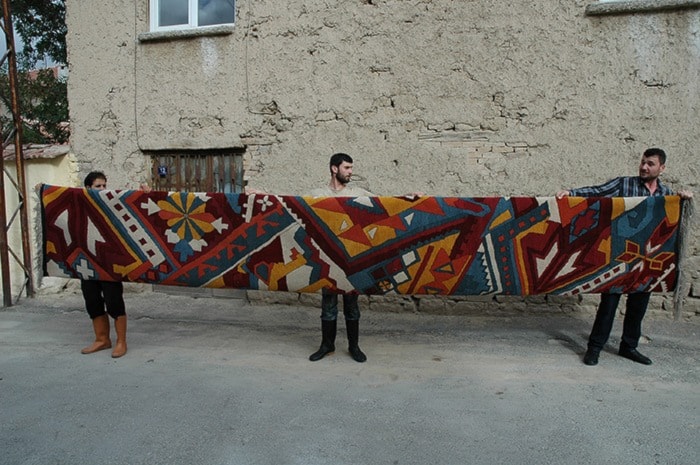Shannon Bool didn't dream of becoming an artist when she grew up.
Oh, she liked to draw all right and once got obsessive about making Ukrainian Easter eggs but that's as far as it went.
"When I was a child, art wasn't considered something a person did as a career," Bool says. "I didn't really know any artists and the few I did know of only created art in their spare time."
She never guessed she'd live in Berlin, exhibit her work in prestigious galleries in Europe and Canada and be featured in a 2013 issue of Canadian Art.
It's almost as if art had to seduce Bool into accepting it as her destiny. In high school, she focused on academics and athletics, fooling around with art on her own. At the University of Victoria she mixed in some life drawing and watercolour classes while pursuing a BA in literature and a minor in psychology.
An art history class convinced Bool to become an art therapist. Her first job was as a youth and family worker in Vancouver. But one semester of night classes at Emily Carr Institute of Art and Design was enough to cause an "a ha!" moment.
Bool quit her day job so she could study art full time. The following year she did an exchange semester at Cooper Union School of Art in New York. That's where she met a German artist who offered Bool the use of her Frankfurt studio.
The studio just happened to be across the street from the internationally recognized Städelschule art academy. It didn't take Bool long to realize that if she attended Städelschule she could prolong her European sojourn.
"The academy was very experimental," she says. "Students didn't take courses they just had a studio and one professor. Many of the professors were well-known artists and filmmakers."
"There was a lot of freedom," she continues. "You could take workshops and attend lectures with any of the other professors. You didn't have to write a thesis to graduate. And if you wanted to do a project you just did it.
"In fact, we were encouraged to do crazy stuff."
Bool credits this unstructured and creative environment to her — and many of the other students — becoming multiple disciplinary artists.
"Instead of focusing on one medium, many of us use two or three and even combine them," she explains. "For instance my husband (Israeli artist Dani Gal) started with sculpture and drawing and is now a filmmaker."
As a Städelschule student, Bool was able to attend lectures at a nearby experimental architectural school. That caused her to consider how objects cover space and the affect that has.
As she explored this concept, her painting style evolved eventually evolving into three-dimensional installations.
"My studies in Germany really allowed me to find right way to say what I want to say," she explains. "And to find different skills that I didn't know I could develop."
After obtaining her Meisterschule, the equivalent of a masters in 2004, Bool and Gal moved to Berlin where they live with their four-year-old son.
"Berlin seemed like a good mid-point between Israel and Canada. We're an international family, living three cultures and speaking three languages," says Bool.
"Europe, especially Germany, has a very rich cultural heritage of supporting the arts and culture," she explains. "People grow up going to museums and exhibits and are really aware of and engaged with culture and art.
"I've been lucky to have so many opportunities in Germany," she adds. "I started studying art quite late but there is so much activity here that I was able to immerse myself in it very quickly."
Last December, Bool completed a two-year project on ornaments and prison. Working with inmates at the Berlin Women's Prison, Bool and the women drew an 18-metre mural in the facility that incorporated images from art deco murals found in private collections. Bool also created sculptures representing the bars on the windows in the century-old prison.
"I made the bars the same height as the windows and took about 20 items that were important to the women in their everyday lives and cast them in bronze," she says. "Then I polished these pieces so they looked like luxury items.
"The currency in prison is chocolate and tobacco, things like that. The value of everything changes when you no longer have free access to it."
In another project, she designed Turkish rugs from a Western perspective and had them brought to life by traditional rug weavers.
Bool is completing a film about an enormous 11-by-four-metre Egyptian carpet that had been found in a museum.
"It's very big and very old," she notes. "I had to go through a lot of hoops to film it in one day. And it cost a lot of money. To meet the insurance requirements I had to hire six men to move the carpet."
Although the majority of Bool's work has been shown in Europe, she's making her mark in the Canadian art world as well. For two years the Daniel Feria Gallery in Toronto has shown her work. On Sept. 12 Bool opened her newest exhibit, Walk Like an Etruscan, at the gallery.
Although Berlin is Bool's home and artistic base, she returns to Comox each year to visit family. And finds it ironic that she moved away to find art and now the Comox Valley is a Mecca for artists.
Paula Wild is a published author and regular contributor to the Comox Valley Record's arts and entertainment section.
